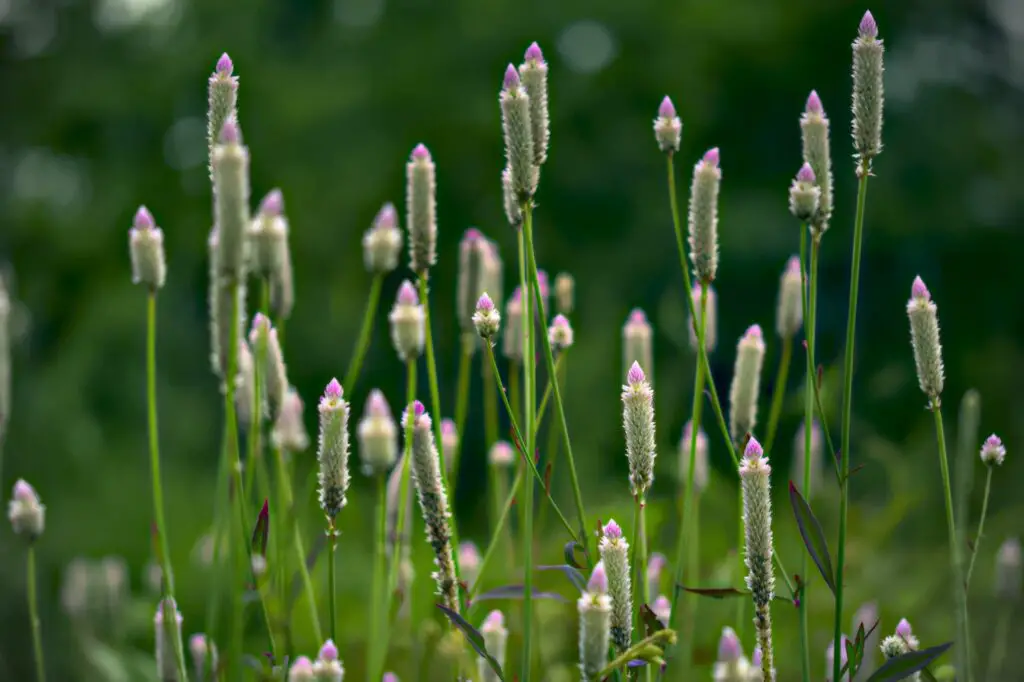Celosia spicata, also known as wheat celosia or spiked celosia, is a unique and stunning flowering plant that is native to Africa and Asia. It is a member of the amaranth family and is commonly grown for its striking blooms that resemble wheat spikes. Celosia spicata is a great plant for indoor gardening as it requires minimal care and is relatively easy to grow.
In this article, we will guide you on how to grow Celosia spicata indoors and care for it throughout its growth cycle.


Table of Contents
Planting Celosia spicata
To start growing Celosia spicata, you need to select a suitable container that is at least 6 inches (15 centimetres) deep and has good drainage. A pot with drainage holes at the bottom is recommended to prevent water from accumulating at the base of the pot and causing root rot.
Next, fill the container with a well-draining potting mix that is rich in organic matter. You can also mix in some perlite or sand to improve the soil’s drainage.
Once you have prepared the potting mix, sow the Celosia spicata seeds about ¼ inch (0.6 centimetres) deep and cover them lightly with the potting mix. Water the seeds gently to ensure that they are evenly moist.
Celosia spicata seeds usually take around 7-10 days to germinate. During this time, it is important to keep the soil moist but not waterlogged. You can cover the pot with plastic wrap or a clear plastic bag to create a humid environment that will help the seeds to germinate faster.
Light Requirements
Celosia spicata requires bright, indirect light to thrive. Place the plant near a window that receives at least 6 hours of sunlight each day. If you don’t have access to natural light, you can use artificial lights to provide your Celosia spicata with the necessary light.
You can use fluorescent lights or LED grow lights that are specifically designed for indoor plants. Hang the lights about 6-12 inches (15-30 centimetres) above the plant and keep them on for around 12-16 hours each day. Be sure to turn off the lights at night to give the plant a chance to rest.
Watering Celosia spicata
Celosia spicata prefers to be kept moderately moist. Water the plant when the top layer of soil feels dry to the touch. Be sure not to overwater the plant as this can lead to root rot.
To check if the soil is dry, if it feels dry, it is time to water the plant. Water the plant until water drains out of the bottom of the pot, then discard any excess water to prevent waterlogging.
Fertilising Celosia spicata
Celosia spicata benefits from regular fertilisation to support its growth and flowering. Use a balanced fertilizer with an NPK ratio of 10-10-10 or 20-20-20. You can also use a slow-release fertiliser that will gradually release nutrients over time.
Fertilise the plant once every two weeks during the growing season (spring and summer). Reduce the frequency of fertilisation during the dormant season (autumn/fall and winter) to once a month.
Pruning Celosia spicata
Pruning Celosia spicata is not necessary, but it can help to encourage bushier growth and more flowers. Pinch back the tips of the plant to promote branching and remove any dead or yellowing leaves to keep the plant looking tidy.
Propagating Celosia spicata
Celosia spicata can be propagated through stem cuttings or by dividing the plant. To propagate through stem cuttings, take a 3-4 inch (7-10 centimetres) cutting from the top of the plant and remove the lower leaves. Dip the cut end in rooting hormone and plant it in moist potting soil. Cover the cutting with a plastic bag or plastic wrap to create a humid environment and keep it in bright, indirect light. The cutting should root in about 2-4 weeks. To propagate by division, gently remove the plant from its container and carefully separate the root system into smaller sections. Replant the smaller sections in their own containers and water thoroughly.
Repotting Celosia spicata
Celosia spicata should be repotted every 1-2 years to provide it with fresh soil and more room to grow. Choose a pot that is one size larger than the current container and has good drainage. Gently remove the plant from its current container and loosen any tangled roots. Place the plant in the new pot and fill in any gaps with fresh potting soil. Water the plant thoroughly and place it in a bright, indirect light location. Be sure not to bury the stem too deeply, as this can cause rotting. Repotting should be done in the spring when the plant is actively growing.
Pest control for Celosia spicata
Celosia spicata is relatively resistant to pests, but it can still be affected by common indoor plant pests such as mealybugs, spider mites, and aphids. If you notice any signs of pests, isolate the plant to prevent the infestation from spreading to other plants. You can use an insecticidal soap or neem oil spray to control the pests. Be sure to follow the instructions carefully and apply the spray when the plant is not in direct sunlight. Regularly inspecting your plant for pests and practicing good hygiene, such as cleaning the leaves and keeping the soil clean, can help prevent pest infestations.
Conclusion
Celosia spicata is a beautiful and versatile plant that can thrive indoors with proper care. It prefers bright, indirect light and well-draining soil that is kept moist but not waterlogged. Fertilising the plant every few weeks during the growing season can promote healthy growth and blooms. Propagating the plant through stem cuttings or division can help you create new plants, while repotting the plant every 1-2 years can ensure it has enough room to grow. If you notice any signs of pests, it is important to act quickly to prevent the infestation from spreading. With these tips and some patience, you can enjoy the stunning blooms of Celosia spicata in your indoor space.
